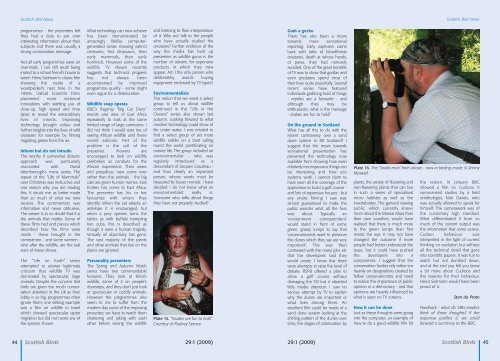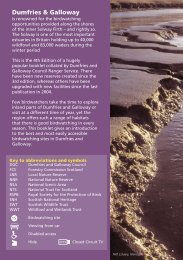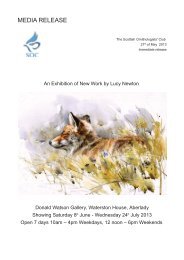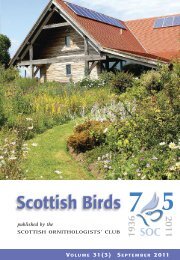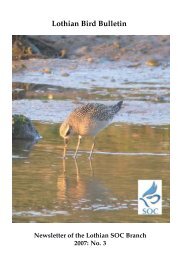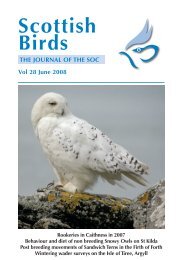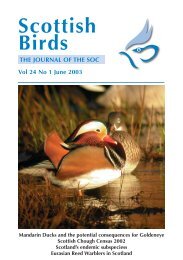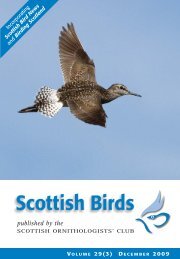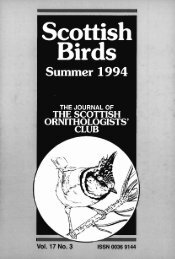*SCOTTISH BIRDS (29) TXT AW - The Scottish Ornithologists' Club
*SCOTTISH BIRDS (29) TXT AW - The Scottish Ornithologists' Club
*SCOTTISH BIRDS (29) TXT AW - The Scottish Ornithologists' Club
Create successful ePaper yourself
Turn your PDF publications into a flip-book with our unique Google optimized e-Paper software.
<strong>Scottish</strong> Bird News<strong>Scottish</strong> Bird Newsprogrammes - the presenters feltthey had a duty to put overinteresting information about theirsubjects and there was usually astrong conservation message.Not all early programmes were onmammals. I can still recall beinginvited to a school friend’s house towatch Heinz Sielmann’s classic filmshowing the inside of awoodpecker’s nest hole in the1950s. Oxford Scientific Filmspioneered more technicalinnovations with startling use ofclose-up, high speed and timelapse to reveal the extraordinarylives of insects. Improvingtechnology brought colour andfurther insights into the lives of wildcreatures for example by filmingmigrating geese from the air.Inform but do not intrude<strong>The</strong> worthy if somewhat didacticapproach was particularlyassociated with DavidAttenborough’s many series. <strong>The</strong>repeat of the “Life of Mammals”over Christmas was instructive andone reason why you are readingthis. It struck me as better madethan so much of what we nowreceive. <strong>The</strong> commentary wasinformative and never obtrusive.<strong>The</strong> viewer is in no doubt that it isthe animals that matter. Some ofthese films had end pieces whichdescribed how the films weremade - these brought in thecameramen - and some women -who after the wildlife, are the realstars of these shows.<strong>The</strong> “Life on Earth” seriesattempted to answer legitimatecriticism that wildlife TV wasdominated by spectacular, largeanimals. Despite the concern thatbirds are given too much conservationattention in the UK as theirlobby is so big, programmes oftenignore them; one striking examplewas a film on wildlife in Israelwhich showed spectacular raptormigration but did not name any ofthe species shown.What technology can now achievehas been demonstrated byamazingly lifelike computergeneratedseries showing extinctcreatures; first dinosaurs, thenearly mammals, then earlyhominids. However some of thewildlife TV shown recentlysuggests that technical progresshas not always beenaccompanied by improvedprogramme quality - some mighteven argue for a deterioration.Wildlife soap operasBBC’s flagship “Big Cat Diary”revisits one area of East Africarepeatedly to look at the samelimited range of large carnivores. Idid not think I would ever tire ofseeing African wildlife until theserecent editions. Part of theproblem is the cult of thepresenter. Viewers areencouraged to look on wildlifecelebrities as conduits for theAfrican experience. <strong>The</strong>ir viewsand prejudices now come overrather than the animals - the bigcats are given human names. EastEnders has come to East Africa.<strong>The</strong> presenter has his or herfavourites with whom theyidentify. When the cat attacks anantelope it is encouraged, butwhen a prey species turns thetables as with buffalo tramplinglion cubs, this is described asthough it were a human tragedy.Virtually all objectivity has gone.<strong>The</strong> vast majority of the plantsand other animals that live on theplains are ignored.Personality presenters<strong>The</strong> Spring and Autumn Watchseries have two commendablefeatures. <strong>The</strong>y look at Britishwildlife, some of it on people’sdoorsteps, and they don’t just lookat spectacular or cuddly animals.However the programmes alsoseem to me to suffer from themodern day curse of the imposingpresenter; we have to watch themchattering and joking with eachother before seeing the wildlifeand listening to their interpretationof it. Why not talk to the peoplewho have actually studied thecreatures? Further evidence of theway the media has built uppresenters as wildlife gurus is thenumber of adverts for expensiveproducts in which they nowappear. Am I the only person whodeliberately avoids buyingequipment endorsed by TV types?Environmentalists<strong>The</strong> notion that we need a selectgroup to tell us about wildlifecontinued in the “Life in theOceans” series also shown lastautumn. Looking forward to whatmodern technology could show oflife under water, I was irritated tofind a select group of yet morewildlife celebs on a boat sailinground the world pontificating onmarine life. <strong>The</strong> group included anenvironmentalist - who wasregularly introduced as adescendant of Jacques Cousteau -and thus clearly an importantperson, whose words must betreasured by lesser mortals. I havedecided I do not know what anenvironmentalist really is.Someone who talks about thingsthey have not properly studied?Plate 15. “Snakes are fun to hold”.Courtesy of Rodney Service.Grab a gecko<strong>The</strong>re has also been a movetowards more sensationalreporting. Early explorers cameback with tales of bloodthirstycreatures, death at whose hands,or paws, they had narrowlyavoided. One of the great benefitsof TV was to show that gorillas andeven predators spend most oftheir lives quite peacefully. Severalrecent series have featuredindividuals grabbing hold of things- reptiles are a favourite - andalthough they may beenthusiastic, what is the message- snakes are fun to hold?On the ground in ScotlandWhat has all this to do with therecent controversy over a sanddune system in NE Scotland? Isuggest that the move towardssensational presentation hasprevented the technology nowavailable from showing how evenrelatively inconspicuous things canbe interesting and how ecosystems work. I cannot claim tohave seen all the coverage of theapplication to build a golf course -and lots of expensive houses - butany onsite filming I saw wasalmost guaranteed to make thepublic wonder what all the fusswas about. Typically an‘environment correspondent’would stand in front of somegreen, grassy lumps to say that‘conservationists want to preservethe dunes which they say are veryimportant’. This was thencontrasted with the many jobs etcthat the developers said theywould create. I know that therewere attempts to raise the level ofdebate. RSPB offered a plan toallow a golf course withoutdamaging the SSI but it attractedlittle media attention. I saw noserious attempt by TV to explainwhy the dunes are important orwhat lives among them. Anexcellent film could be made of asand dune system looking at theshifting pattern of the dunes overtime, the stages of colonisation byPlate 16. <strong>The</strong> ‘Snake-man’ from above - now in birding mode © JimmyMaxwell.plants, the variety of flowering andnon-flowering plants that can livein such a series of specialisedmicro habitats as well as theinvertebrates. <strong>The</strong> general viewingpublic, which currently knowsmore about the Maasai Mara thantheir own coastline, would haverealised that there is much moreto the green lumps than firstmeets the eye. It may not havechanged the outcome if morepeople had better understood theissue, but it could have pushedthe developers into acompromise. I suggest that theconservation bodies rely rather tooheavily on designations created byfellow conservationists and needto realise the importance of publicopinion in a democracy - and thatopinions are heavily influenced bywhat is seen on TV screens.How it can be doneJust as these thoughts were goinginto the computer, an example ofhow to do a good wildlife film hitthe screen. In January BBCshowed a film on Cuckoos. Itsummarised studies by a fieldornithologist, Nick Davies, whowas actually allowed to speak forhimself. <strong>The</strong> camerawork was ofthe customary high standard.What differentiated it from somuch of the current output wasthe information that came across.Cuckoo behaviour wasinterpreted in the light of currentthinking on evolution but withoutall the technical detail that goesinto scientific papers. It was fun towatch but not dumbed down,and at the end you felt you knewa bit more about Cuckoos andthe reasons for their behaviour.Heinz Sielmann would have beenproud of it.Stan da PratoFeedback - what do SBN readersthink of these thoughts? If theresponse justifies it, we couldforward a summary to the BBC.44<strong>Scottish</strong> Birds<strong>29</strong>:1 (2009)<strong>29</strong>:1 (2009)<strong>Scottish</strong> Birds45


